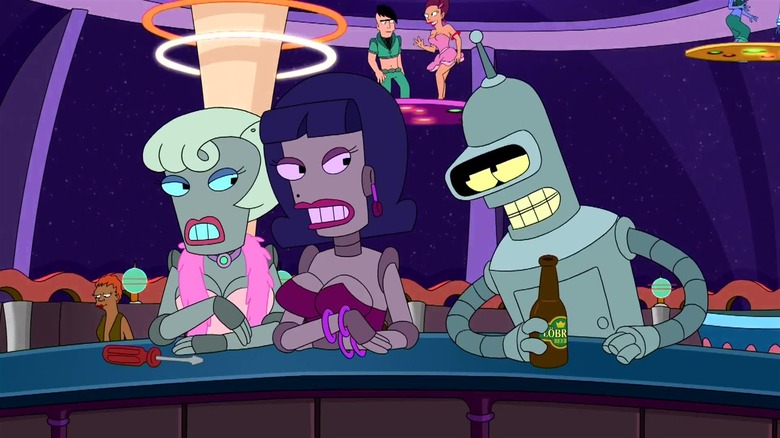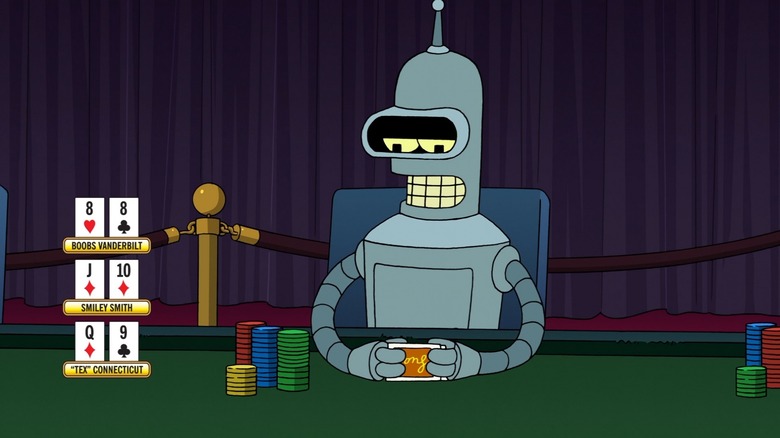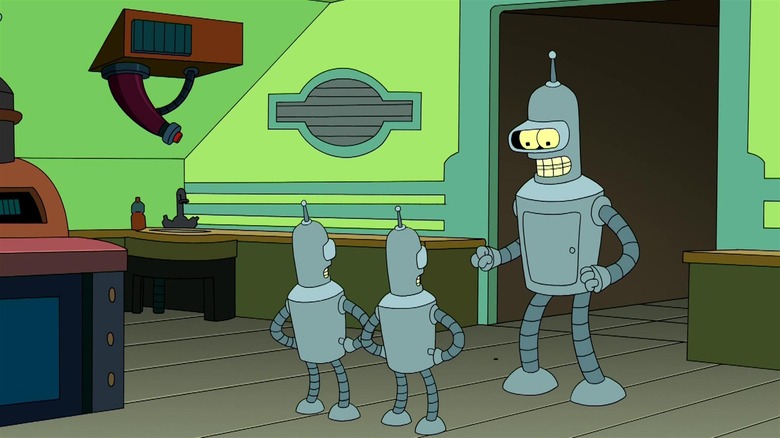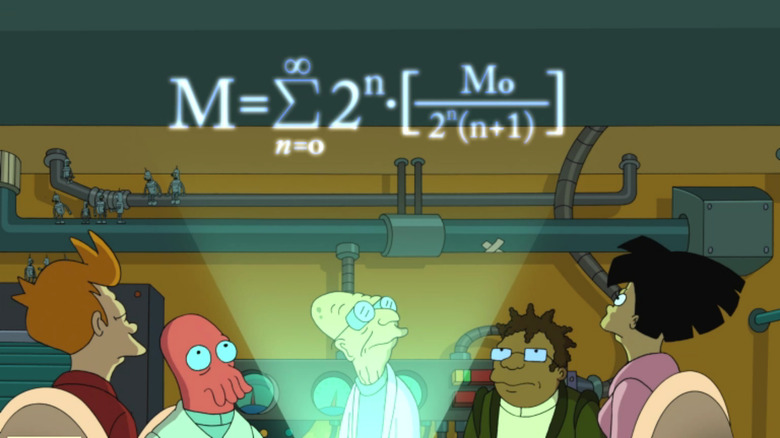Bender's Serial Number In Futurama Has A Hidden Meaning
While Matt Groening's and David X. Cohen's repeatedly resurrected animated sci-fi sitcom "Futurama" may contain more than its fair share of crass jokes, funny "dumb" characters, and all manner of lame puns, it doesn't take a very sophisticated viewer to recognize that it comes from the minds of very smart people. For every crude joke, there will be a deeply intellectual reference, eight-dollar word, or scientific reference that requires a dive to the encyclopedia. To cite one example, a wide shot of Saturn might reveal a tiny sign posted next to the gap in its rings. A close look reveals that it reads "Mind the Keeler Gap." This is a play on both "Mind the Gap" cautionary signs one might see in the London Underground, as well as a reference to the Keeler gap, the actual scientific name for that space between Saturn's rings. It's not a coincidence that joke was penned by "Futurama" writer Ken Keeler.
There are so many throwaway background gags of this nature in "Futurama," one would need an advanced degree in mathematics to understand them all (I had to look up why the local movie theater was called the ℵ0-plex), and viewers can rest assured that if something might look or sound like a brainly mathematical reference, it probably is. This comes from a show that regularly employs a coded alien language in most every episode.
In the episode "XMas Story" (first aired December 19, 1999) Bender the alcoholic robot (voiced by John DiMaggio) receives an XMas card from his mom, a robotic assembly-line arm. His "mom" referred to him as "Son #1729." That number appears regularly on "Futurama" and has a significance non-mathematicians may not be aware of.
Ken Keeler, mathematician sitcom writer
Not only is 1729 Bender's serial number, but it's also the call letters on The Nimbus, an outsize military vessel belonging to blowhard captain Zapp Brannigan. It also appeared as a multiverse designation for a universe full of bobblehead people. 1729 was brought to the show by Keeler, possessor of a PhD in Applied Math from Harvard (the title of his thesis was "Map Representations and Optimal Encoding for Image Segmentation"), and often the source of the show's brainier number gags.
Keeler explained his thinking on how he came to that number in an interview with Appalachian State University back in 2008, as well as how math helps him as a creative writer:
"Mathematical training makes you good at following logical structure, and I think that's a plus in any field. In writing, it helps you to see the steps you need to lay out to make a story hang together. I also think studying hard math problems teaches you how to just disconnect from your current approach sometimes and force yourself to come up with a radically new one. This is kind of an effective method of coming up with jokes when you're stuck; I guess maybe it helps you achieve the element of surprise. And the way a mathematician will exhaustively explore the consequences of an assumption or a result is kind of similar to the way multipart jokes are occasionally built up; you've started down a road and you want to see how far it'll take you."
The Hardy-Ramanujan Number
When asked to come up with an "amusing" number by Cohen, the show's executive producer, Keeler came up with one quickly:
"We needed a number for plot reasons, and David Cohen asked if I could think of an interesting one, and the Hardy-Ramanujan sum-of-two-cubes story leapt to mind. Afterwards David sort of went to town with the idea whenever we needed a serial number.
Because he was talking to a university, Keeler didn't need to stop and explain what the Hardy-Ramanujan story was all about, so here's some backstory. In 1940, British Mathematician G.H. Hardy, the anecdote goes, was visiting a friend, mathematician Srinivasa Ramanujan in the hospital. From Hardy's own mouth:
"I remember once going to see him when he was ill at Putney. I had ridden in taxi cab number 1729 and remarked that the number seemed to me rather a dull one, and that I hoped it was not an unfavorable omen. 'No,' he replied, 'it is a very interesting number; it is the smallest number expressible as the sum of two cubes in two different ways.'"
In numerical language, that would look like: 1729 = 13 + 123 = 93 + 103.
Keeler, in employing a simple four-digit number in a sci-fi cartoon, was referring to a nerdy observation made by other mathematicians in 1940 who were merely chinwagging about the number on a taxi. This might be referred to as a nerd turducken.
The OTHER Hardy-Ramanujan number
If the Hardy-Ramanujan number is the smallest number expressible as the sum of two cubes in two different ways, is there a further Hardy-Ramanujan number that is the smallest number expressible as the sum of two cubes in three different ways? Why, curious reader, of course there is. The tertiary Hardy-Ramanujan number is 87,539,319. Which can be expressed as 1673 + 4363 = 2283 + 4233 = 2553 + 4143. That number would be included as — fittingly enough — a taxicab number in the 2007 "Futurama" movie "Bender's Big Score." Keeler brought a throwaway math gag full circle.
And who said they wanted a quaternary Hardy-Ramanujan number? Surely there were cheers from the back! Well, friends, the Hardy-Ramanujan party will continue indefinitely! Say it with me! 6,963,472,309,248! That can be expressed as ... That's right! 2,4213 + 19,0833 = 5,4363 + 18,9483 = 10,2013 + 18,0723 = 13,3223 + 16,6303.
There's a quinary Hardy-Ramanujan number as well (48,988,659,276,962,496), but breaking it out would be silly.
"Futurama" will return to Hulu in the near future, with the entire cast returning (DiMaggio briefly had a contract dispute that was eventually resolved). Be sure to study your discreet math, because there will most assuredly be discreet math jokes.



